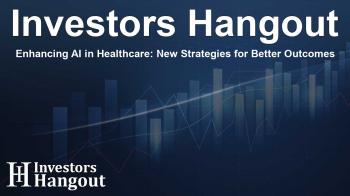Enhancing AI in Healthcare: New Strategies for Better Outcomes

Introduction to AI in Healthcare
The application of artificial intelligence (AI) in healthcare is becoming increasingly prevalent. As hospitals leverage AI to boost efficiency and patient outcomes, ensuring the integrity of the data used in these systems is vital. A recent study from York University highlights the importance of specific learning strategies aimed at enhancing the effectiveness of AI models in hospitals.
Understanding Data Shifts
Applying AI technologies in medical settings, like hospitals throughout the Greater Toronto Area, poses specific challenges. One of the main concerns is what happens when the training data for AI models does not accurately mirror real-world patient data. This discrepancy can unintentionally lead to patient risk. Researchers conducted an extensive study to explore these risks and how to mitigate them effectively.
The Research Framework
In their research, the team developed an early warning system focused on predicting in-hospital patient mortality. The project assessed seven large hospitals in the Greater Toronto Area using data from GEMINI, Canada's most extensive hospital data-sharing network.
Analyzing Patient Encounters
The study evaluated data connected to over 143,049 patient encounters, including lab results and admissions from varying sources like acute care institutions and nursing homes. Through this analysis, the team was able to identify critical shifts in data that could affect model performance.
The Role of Learning Strategies
According to the lead researchers, proactive, continual, and transfer learning strategies are essential in combating data shifts. As stated by Elham Dolatabadi, an assistant professor at York's School of Health Policy and Management, building robust AI models can often fall short if they fail to adapt to changing data landscapes.
Continual Learning in Action
Adopting a continual learning approach allows AI models to be regularly updated as new data comes into play. This method is crucial, especially in light of unpredictable variables such as changing demographics, medical practices, and even public health emergencies like pandemics. The research demonstrated that AI models with drift-triggered continual learning mechanisms showed improved performance over time.
Transfer Learning Benefits
Another strategy highlighted was transfer learning, which enables an AI model to transfer knowledge acquired from one domain to another. The researchers observed significant advantages when models trained on data from community hospitals were adapted for use in academic hospitals, underscoring the importance of understanding each hospital's unique patient population.
Challenges with AI Implementation
Despite the advancements in AI, the study pointed out critical challenges, including biases in AI training data that may lead to unfair outcomes for specific patient groups. By identifying and addressing these challenges, clinicians can ensure that AI's deployment in healthcare settings does not inadvertently contribute to negative patient experiences.
Proactive Monitoring Solutions
The study also introduces a proactive, label-agnostic monitoring pipeline aimed at detecting harmful data shifts. This practical approach serves not only to protect patient safety but also to ensure that AI models maintain their effectiveness in clinical contexts.
Insights from the Study
Vallijah Subasri, the first author and AI scientist, emphasized the study's significance for clinical AI adoption. The findings illustrate a pathway for improving the deployment of AI in healthcare settings, bridging the gap between theoretical potential and real-world outcomes.
The Future of AI in Healthcare
The recent advancements and strategies proposed in the research signify a promising direction for the integration of AI in hospitals. As healthcare professionals and AI developers work together, the goal remains to provide safe, effective, and equitable care for all patients.
Frequently Asked Questions
What are the primary goals of AI in hospitals?
The primary goals of AI in hospitals include improving patient outcomes, reducing operational costs, and enhancing the efficiency of medical services.
How significant are data shifts in AI performance?
Data shifts can critically impact AI performance, potentially leading to inaccurate predictions and unsafe patient care if not adequately addressed.
What is proactive monitoring in AI?
Proactive monitoring involves continuously assessing AI models to detect and address any shifts in data that might lead to harmful effects in clinical settings.
How does transfer learning benefit AI models?
Transfer learning helps AI models apply knowledge from one area to another, improving their adaptability and performance across different clinical environments.
What is the impact of biases in AI models?
Biases in AI models can lead to unfair treatment of certain patient groups, potentially causing disparities in diagnosis and care.
About The Author
Contact Kelly Martin privately here. Or send an email with ATTN: Kelly Martin as the subject to contact@investorshangout.com.
About Investors Hangout
Investors Hangout is a leading online stock forum for financial discussion and learning, offering a wide range of free tools and resources. It draws in traders of all levels, who exchange market knowledge, investigate trading tactics, and keep an eye on industry developments in real time. Featuring financial articles, stock message boards, quotes, charts, company profiles, and live news updates. Through cooperative learning and a wealth of informational resources, it helps users from novices creating their first portfolios to experts honing their techniques. Join Investors Hangout today: https://investorshangout.com/
The content of this article is based on factual, publicly available information and does not represent legal, financial, or investment advice. Investors Hangout does not offer financial advice, and the author is not a licensed financial advisor. Consult a qualified advisor before making any financial or investment decisions based on this article. This article should not be considered advice to purchase, sell, or hold any securities or other investments. If any of the material provided here is inaccurate, please contact us for corrections.

